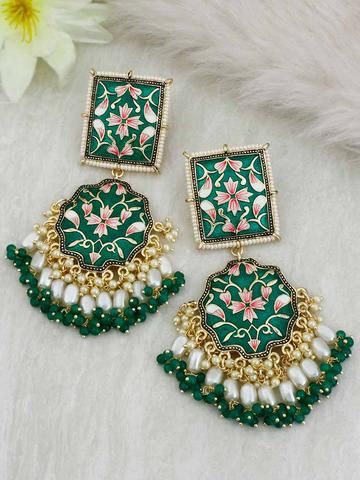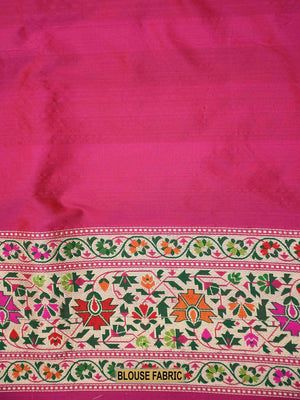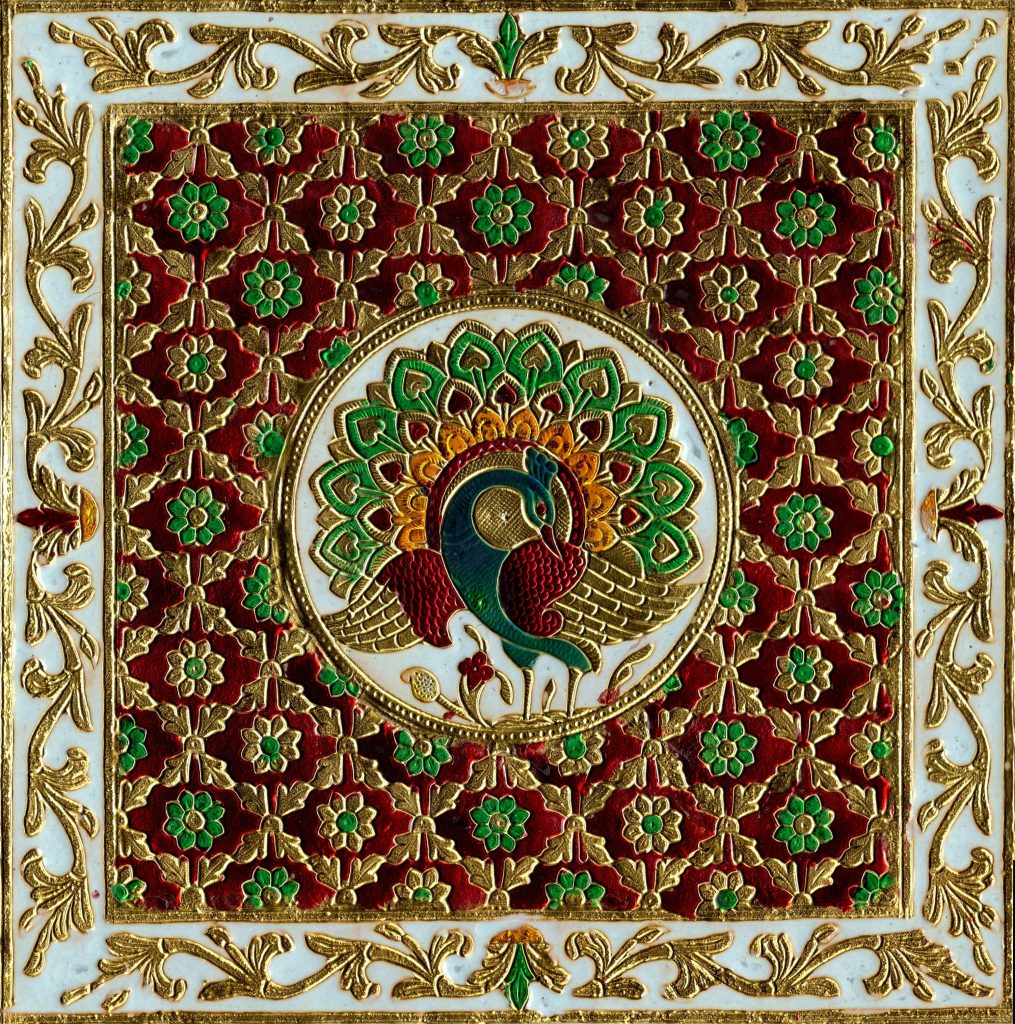Meenakari (enameling) is an archaic art form of India in which Meena is a solid mixture made of glass powder and chemicals. While they are molten, they are colored by mixing metal oxides and minerals. Meenakari is the art of decorating any metal surface. In the word Meenakari, Meena refers to enamel, and Kari means art. Meena means “heaven” in the Farsi language i.e., the blue color of heaven.

The earliest Meenakari ornaments found date back to the 13th BC. These ornaments were made in Cyprus, in the eastern Mediterranean, during the Mycenaean Greek period (1600-1100 BC). The Mycenaean Greek Age was the final period of the Bronze Age in Ancient Greece. This was the time when artists used to decorate gold rings with Meena. Since then, Meenakari is being done not only on the jewelry but also on other things all over the world. It is believed that the type of Meenakari that we see in India today is the contribution of Iranian craftsmen in the Sassanid (Sultanate) era of Iran (3rd to 7th centuries).
This art flourished in Iran and was brought to India by the Mughals. The Mughals, under the leadership of Prince Babur of Turko-Mongol descent, invaded India during the 16th century. Art, culture, craft, and architecture flourished under Mughal patronage for the next two centuries. The art of jewelry-making flourished during the reign of the Mughals. According to the evidence found during the Mughal reign, Meenakari’s work was used in the royal ornaments at that time. Akbar, Jahangir, and Shah Jahan are believed to have worn meenakari jewelry. Interestingly, apart from earrings, rings, earrings, and necklaces, hookahs, sword hilts, and boxes also had fine meenakari work. We can see the beauty of Mughal jewelry in the collection of miniature paintings. Apart from the National Museum in Delhi, some other museums in the country have some old Meenakari ornaments.

When this art of jewelry decoration was flourishing in India, even the royal families adopted it. The Maharajas of princely states like Patiala and Jaipur patronized this art. The most famous meenakari in India is found in Rajasthan, especially in its capital, Jaipur. Raja Man Singh-I, the Kachwaha ruler of Amer in the 16th century, is believed to have brought skilled meenakars from Lahore and employed them in his court. This art later reached Jaipur. Jaipur was established in 1727 as the new capital of Kachwaha. Maharaja Sawai Jai Singh-II had made Jaipur his capital instead of Amber at the time. Jai Singh was an admirer and patron of the arts, and he had brought craftsmen from all corners of India and settled them in Jaipur. At that time, Jaipur was considered the center of trade and commerce. It is believed that he also brought Meenakaars from Iran and settled them here. Since then, the art of meenakari has flourished in the city of Jaipur.
The artisans who do Meenakari work are called Meenakaars. There are many families of Meenakars in Jaipur who have been doing this work for many generations. Some of these families believe that their forefathers were sent to Iran to learn this trade and also received the National Award for Meenakari.
The process of Meenakari
In the streets of old markets like Kishanpole Bazaar in the city of Jaipur, you will find many shops selling Kundan-Meenakari jewelry and other items. This type of jewelry is very popular in North India.
There are different techniques used for meenakari in the world, but the technique popular in India is called champlevé, which in French means raised place. In this technique, the Meena is filled in the depressions made in the metal, and the edges of the metal are left out.
The process of making Meenakari jewelry is long and consists of several steps. A piece of Meenakari passes through many skilled hands. It takes an average of 4-5 days to make even a small meenakari piece of jewelry. The first step in the process is called wharf-making. In this, the foundation for the Meenakari portion of the jewelry is prepared.
The metal is first melted by placing it on fire. Then its wire or sheet is made, then it is given the desired shape. In this process, the metal is pressed into shape, and sieving is also done. For example, if a flower-like earring is to be made, then in this process the metal is given the shape of a flower. This work is very complicated and tiring.
In the next step, the design is made on the base. Motifs such as bells, flowers, birds, bellbutes, and khushanvisi are popular in Indian Meenakari. Craftsmen make patterns or designs by hand, even on the smallest ornaments. The design is then engraved. Other tools, including the needle, are used to engrave the design on the surface of the metal. After engraving, the metal is washed before enameling.
Meenakari’s work starts with Meena (enamel) only. Craftsmen have meena of different colors available in small pieces or cakes. These means are imported from Amritsar in India or France and Germany. Small pieces are made of this Meena. Then the fine powder is made. Water is used in this work. The meena powder is then poured onto the coloring sheet. Generally, blue, green, red, and white colors are used in Meenakari. Very carefully, a little bit of enamel is taken from the sheet and it is filled in with the engraved design. Meena is filled with great care, even in the tiniest of designs.

When the metal piece is completely filled with meena, it is cooked. According to Mr. Mukesh, earlier the meena was cooked in a furnace, but now electric ovens have come, due to which this process has become faster and easier. The process of stuffing and cooking is done five to six times. Each time, the enamel melts a little and eventually fills every part of the engraved design. Interestingly, the original color of Meena is visible only after it is cooked.
The next step in the process is finishing. This process is called Manjhai, in which the metal is made shiny and smooth. After this, it is cooked again. After ripening, it is cleaned with acidic liquid or tamarind water, which makes it shine. In this way, a beautiful piece of Meenakari is prepared. After meenakari, the work of Kundan-jadai is done on the ornaments. Sometimes other types of stones are also used in it.

Swaliha Malik
Swaliha Malik is a History undergraduate at Miranda House who is curious to Religion and Modern History. Apart from being a history buff, she is a feminist who sees the world and societal norms through critical lenses. In her free time she binge watches, read, research and drinks coffee.

